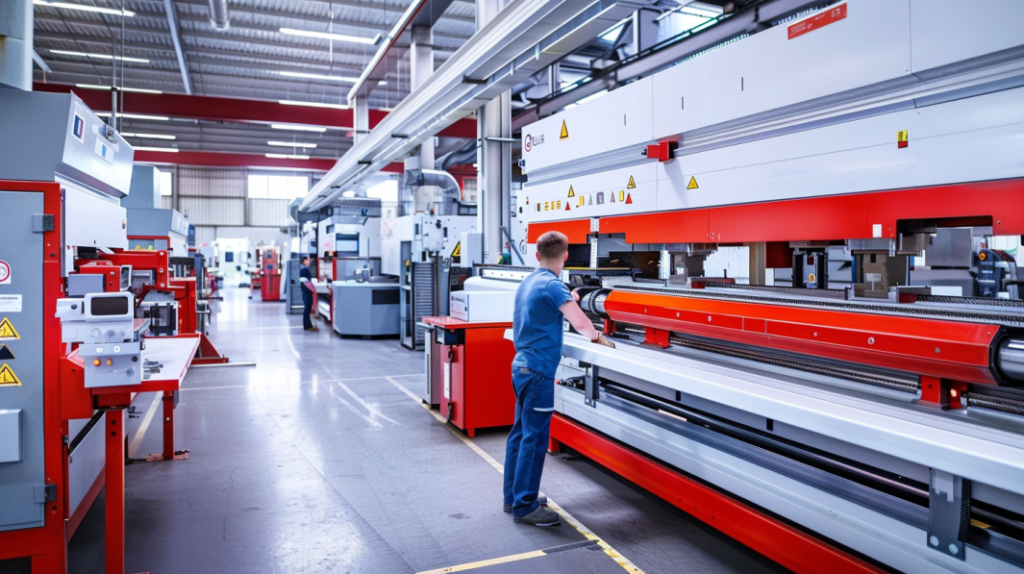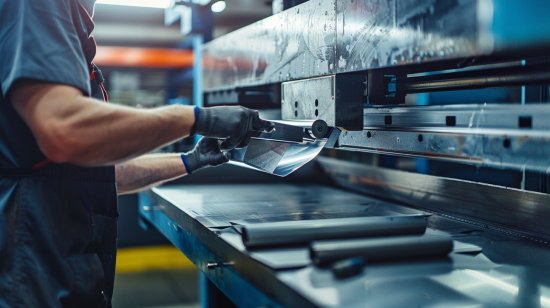Sheet metal folding can be tough. There are a lot of factors to consider, and it can be overwhelming. However, when you understand the basics, bending sheet metal is simple and the results are amazing. Here’s what you need to know about sheet metal bending to make it easy and approachable for your next project.
Sheet metal folding, also called forming, involves shaping a flat sheet of metal into angles and forms using various techniques and tools. It is crucial to creating functional parts for many industries, including aerospace, automotive, and electronics. By getting the basics down, you will be able to build your fabrication skills and make sure your parts are made to the right specification.
Sheet metal folding is critical to manufacturing. You are taking a flat sheet of metal and turning it into a useful part. Whether you are a beginner or an experienced fabricator, understanding the basics will help you be more efficient and make better parts. This guide will cover everything from picking the right material to tooling, and help you understand all the ins and outs of sheet metal folding.

What is Sheet Metal Folding?
Sheet metal bending, often referred to as forming, is a critical step in the fabrication process. Once the metal is cut to size, the next step is to bend or form it into the desired shape. This is necessary to create parts that fit together correctly in a wide range of applications, from industrial equipment to consumer electronics. Without proper bending, you would not be able to achieve the necessary structural integrity or functionality.
Why is Sheet Metal Folding Important?
Sheet metal bending takes flat sheets and turns them into three-dimensional parts needed for assembly and product functionality. It lets you make brackets, enclosures, panels, and other critical parts. By understanding the importance of sheet metal bending, you can make sure your products are strong, reliable, and meet the necessary specifications.

How to Fold Sheet Metal?
There are a few different ways to fold sheet metal, depending on the material and the application. The main requirement for folding is to apply enough force to the metal to exceed its yield strength. You can do this by hand or with a machine like a press brake. Here are a few methods:
Manual Folding
Hand folding involves using hand tools or heating the metal to make it bendable. This method is typically used for simple bends and smaller jobs. While it’s cheap, hand folding requires skill and precision to get the job done right.
Machine-Assisted Folding
Press brakes are the most common way to fold sheet metal. They work by using a punch and die system to apply controlled force to bend the metal. Press brakes are versatile and can handle a wide variety of materials and thicknesses, making them ideal for larger, more complex projects.

What is the Purpose of Folding in Sheet Metal Work?
The purpose of folding sheet metal is to shape it into the specific forms needed for the final product. This is important to make sure all the parts fit together correctly and work the way they’re supposed to. By folding sheet metal, you can make all kinds of parts, from simple brackets to complicated enclosures, you need to put together products and make them work.
The Sheet Metal Folding Process
Folding sheet metal involves several steps that require attention to detail and precision. Here’s how it works:
Material Selection
The first step in folding sheet metal is picking the right material. The thickness of the material, how easy it is to bend, and how strong it is all play a role in how the metal will behave when you bend it. Common materials include aluminum, stainless steel, and galvanized steel.
Setting Up the Press Brake
After you have your material, you need to set up the press brake with the right punch and die. You have to program the machine to bend the metal the right way and make sure it bends to the right angles.
Positioning the Metal Sheet
You carefully position the sheet metal on the press brake. It’s important that the metal is lined up properly so you get good bends. The machine clamps the metal and bends it according to the program you set up, taking into account things like bend allowance and springback.
Applying the Bends
The press brake applies the right amount of force to bend the metal to the angles you programmed. You might have to make multiple bends to make complicated shapes. You have to pay attention to make sure each bend is right and lines up with the design.
What is a Bend Radius in Sheet Metal?
The bend radius is the inside curve of a bend. You need to get the bend radius right to avoid cracking the material and to make sure the part is strong. The right bend radius depends on the thickness and type of material. You should over-bend the material a little to account for springback, where the metal goes back to its original shape a little bit.
Bend Allowance and Deduction
What is Bend Allowance?
The bend allowance is the amount of extra material needed to account for the stretching that occurs when you bend the metal. You need to figure out the bend allowance to make sure the part is the right size. The bend allowance is calculated based on the material type, thickness, and bend radius. The formula is typically:
Bend Allowance=(Inside Bend Radius+2/Material Thickness)×Bend Angle (in radians)
By doing this calculation, you can figure out how much the material will stretch and adjust your design if needed.
What is Bend Deduction?
The bend deduction is the amount you subtract from the total length to account for how much the metal compresses when you bend it. You need to know both the bend allowance and the bend deduction to make sure you make the part you want. The bend deduction formula is based on the same factors as the bend allowance, but it focuses on how much material is effectively removed due to the bend:
Bend Deduction=2×(Outside Setback−Bend Allowance)
If you know these values, you can know how to lay out the flat pattern of the sheet metal before you bend it.
Grain Direction
How Grain Direction Affects Sheet Metal?
The grain direction of sheet metal affects how it bends. Bending across the grain helps prevent cracking and makes for a smoother bend. This is especially important with materials like aluminum, which can have problems related to the grain. The grain direction is the orientation of the metal’s crystal structure that happens when the metal is rolled. Bending with the grain can cause problems like cracking, but bending across the grain helps spread the stress out more evenly across the metal.
How to Identify Grain Direction?
You can usually see the grain direction by looking at the surface of the sheet metal and watching for lines or patterns that show you the direction. Bending across the grain will make your parts last longer and look better.
Tooling and Machine Selection
How to Choose the Right Tooling?
Having the right tools and machines is important to bend sheet metal accurately and efficiently. Press brakes with the right punches and dies can bend a wide range of materials and thicknesses. Keeping your machines maintained and calibrated helps you get good bends every time. Here’s how to choose the right tools:
• Materials: You have to make sure the tooling works with the kind of metal you’re using.
• Bend Radius: You need a punch and die that will bend the metal the way you want without causing defects.
• Thickness: You have to make sure the press brake can bend the thickness of metal you’re using.
• Types of Tools: You can choose air bending, bottom bending, or coining tools based on how precise you need the bend to be and the type of bend you’re making.
Using the right tools helps you get good, repeatable bends, so you don’t waste material and you get good parts every time.
Springback
What is Springback?
Springback is when metal goes back to its original shape a little bit after you bend it. You need to know about springback when you bend metal to get the part to the angle you want. You can either change the angle you bend the metal to or use special tooling to help with springback.
Factors Affecting Springback
- Material Type: Different metals have different amounts of springback because they have different strengths and flexibility.
- Bend Radius and Angle: You usually get more springback when you make tight bends or use a bigger angle.
- Thickness: Thicker materials generally have less springback than thinner materials.
How to Deal with Springback
To deal with springback, you usually have to bend the metal more than you want. You can also use tools that are made to help with springback, like bottoming dies or coining tools, to get the bend right.
Bend Sequence
Why is Bend Sequence Important?
You need to know the order of bends to make sure you don’t run into each other and to make sure you can actually make the part. With complicated parts, you need to know the right way to bend them so you don’t mess up your material or your tools. Knowing the right order makes you faster and better at bending.
Tips for Effective Bend Sequencing
- Start with Simple Bends: Do the easy bends first so you don’t get in the way of the other bends.
- Plan for Accessibility: Make sure you can get to all the places you need to bend without running into anything.
- Minimize Handling: Try to plan your bends so you don’t have to move the metal too much from one bend to the next.
- Use Software: CAD software can help you see how to bend the part and can help you figure out the best way to bend it without messing up.
Knowing how to bend in the right order helps you work better and faster, and you won’t mess up your bends.
Bend Relief
What is Bend Relief?
Bend reliefs are little cuts or notches you put near bends to keep the metal from tearing or getting messed up. You need to use bend reliefs when you have a lot of bends close to each other. Using bend reliefs makes your bends look better, makes them more accurate, and keeps the part strong.
Importance of Bend Relief
- Prevents Tearing: Stops the metal from tearing at the bend.
- Improves Accuracy: Makes sure the bend happens where you want it to be.
- Enhances Durability: Stops the metal from breaking early because of stress.
How to Design Bend Reliefs
Bend reliefs should match the thickness of the material and the bend radius. They are usually squares or triangles and go right at the end of the bend. The size and shape of the relief depend on the material you’re using and how you’re bending it.
Minimum Flange Length
What is Minimum Flange Length?
You need to have the flange length at least four times the material thickness to make sure you get good bends without messing up the metal. Making sure the flange length is right is important to keep the part strong and looking good.
Why Minimum Flange Length Matters
- Prevents Deformation: If you have a short flange, the metal can buckle or warp when you bend it.
- Ensures Precision: Having a good flange length helps you control the bend better, so you get good bends.
- Maintains Structural Integrity: Longer flanges spread the stress out more evenly, so the part is strong and lasts longer.
Calculating Minimum Flange Length
To figure out the minimum flange length, look at the material thickness and bend radius. A good rule of thumb is to keep the flange length at least four times the material thickness. This way, you can bend the part well without messing it up.
Conclusion
It’s important to know the basics of bending sheet metal to get good, accurate parts. If you understand these basic ideas, you can make better parts, make them the right way, and make them faster. Whether you’re making a simple part or a complicated one, these basics will help you make parts that are strong and last a long time.

